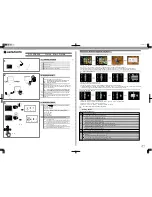
HD408L User Guide
HD408L User Guide
10
amscope.com
Image Exposure
Manual Exposure
Image exposure controls the amount of light captured by the imaging device. Exposure time is used to set the amount
of time over which light is collected. More time will result in a brighter image. For most static subjects, increasing expo-
sure time to achieve the appropriate brightness is the preferred method. For moving subjects, too much time will result
in blurring as the subject’s location changes over time. Exposure time must be limited in these cases to prevent excess
movement. Use of the gain setting would therefore be the preferred method to achieve optimal brightness. Gain controls
the amount of amplification applied to the signal generated by the imaging sensor. While the signal strength would be
increased, noise generated during the imaging process would also be increased.
Auto Exposure
Auto exposure relies on software to set the exposure time and gain. This simplifies the workflow, especially when captur-
ing images in changing lighting conditions. As a microscope’s magnification changes, or the distance from the microscope
to the subject changes, the amount of light collected will also change. Auto exposure can continuously compensate for
these changes. This method assumes that the optimal amount of light would create an image with levels which would
average to a middle tone. Because of this, images of light subjects may appear too dark, and images of dark subjects may
appear too bright. For this reason, adjustment can be done using the exposure compensation control, sometimes called
exposure target. This allows you to increase or decrease the target level of brightness.
Color
White Balance
The color of an object is influenced by the color of light reflecting off of it or passing through it. Different light sources
produce light with different color-biases. Common examples are incandescent lamps which typically produce warm
colors compared to fluorescent or LED lamps which produce cooler colors. This sort of bias is referred to as color tem-
perature. Due to this phenomenon, a white object may appear slightly yellow in morning sunlight, and slightly blue in
afternoon shade. To compensate for these variations, digital imaging devices can process images using what is called
“white balance.” The white balance process shifts colors based on the color of the light source, with the goal of produc-
ing a more neutral white or grey.






































